Relational Model¶
约 1647 个字 18 张图片 预计阅读时间 5 分钟
Structure of Relational Databases¶
Concepts¶
Formally, given set \(D_1, D_2, \ldots, D_n\) a relation \(r\) is a subset of \(D_1\times D_2\times \ldots D_n\).
Thus a relation is a set of n-tuple \((a_1,a_2,\ldots,a_n)\) where each \(a_i\in D_i\).
\(A_1,A_2,\ldots,A_n\) are attributes. \(R=(A_1,A_2,\ldots,A_n)\) is a relation schema.
e.g. instructor = (ID, name, dept_name, salary).
A relation instance \(r\) defined over schema R is denoted by \(r(R)\).
因为关系是一个集合,所以关系都是无序的。
Attributes¶
- The set of allowed values for each attribute is called the domain ( 域 )of the attribute
- Attribute values are (normally) required to be atomic ( 原子的 ); that is, indivisible
- The special value null ( 空值 ) is a member of every domain
Database Schema¶
- Database schema -- is the logical structure of the database.
- Database instance -- is a snapshot of the data in the database at a given instant in time.
Example

schema 是抽象的定义 , instance 是具体的实例。
Keys¶
Let \(K\subsetneqq R\)
- \(K\) is a superkey ( 超键 ) of \(R\) if values for K are sufficient to identify ( 唯一确定 ) a unique tuple of each possible relation \(r(R)\)
e.g. \(\{ID\}\) or \(\{ID, name\}\) - Superkey \(K\) is a candidate key ( 候选键 ) if \(K\) is minimal.
即 \(K\) 中没有冗余属性 - One of the candidate keys is selected to be the primary key ( 主键 ).
-
Foreign key ( 外键 ) Relation \(r_1\) may include among its attributes the primary key of another relation \(r_2\). This attribute is called a foreign key from \(r_1\), referencing \(r_2\).
类似于指针,外键限制就是关系 \(r_1\) 引用的主键必须在关系 \(r_2\) 中出现。Example

左侧表的老师 ID 必须出现在右侧表中。
Why we need foreign key constraint?
数据库是支持由完整约束条件定义出来的,并维护完整性约束条件。则当我们定义外键后,上述例子中黄色条目是不会出现的。
-
Referential integrity ( 参照完整性 )
类似于外键限制,但不局限于主键。Example

这里 \(time_slot_id\) 并不是关系 \(r_2\) 的主键,所以这里不是外键限制。
Example
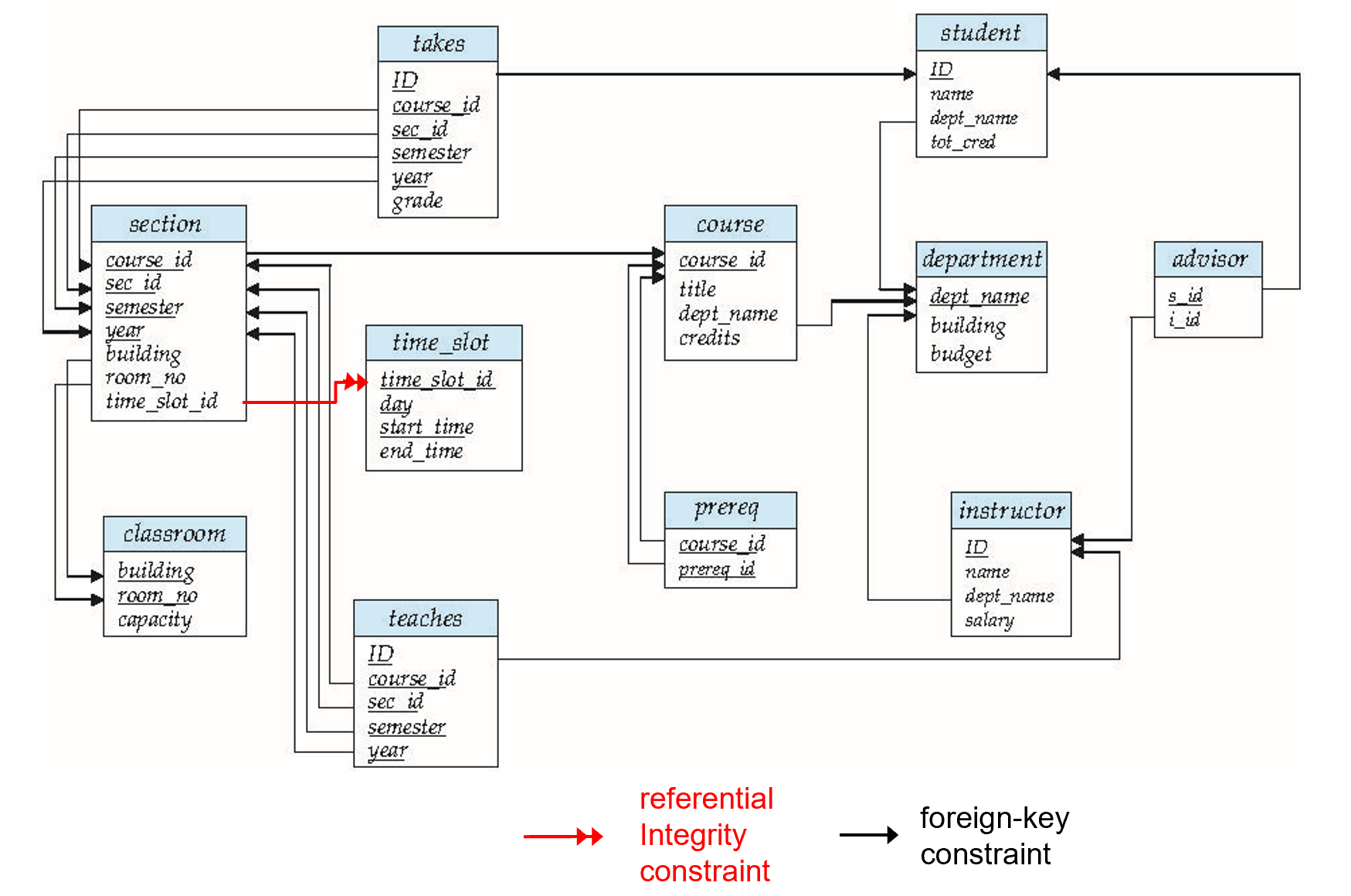
- course 指课程信息,无论是否开课,都会有其定义。
- section 表示教学班,真正开课时就有相应的实例
。 (类比于高铁的列车号,和每天对应的班次) - teachers 具体教哪个教学班的老师
- takes 表示学生注册课程
- time_slot 表示一门课的具体上课时间段,如数据库在周一 3, 4, 5 节 ; 周一 7, 8 节。
- 上图中红线表示引用完整性的约束;黑线表示外键约束。
Relational Algebra¶
Six basic operators
- select: \(\sigma\)
- project: \(\Pi\)
- union: \(\cup\)
- set difference: \(-\)
- Cartesian product( 笛卡尔积 ): \(\times\)
- rename: \(\rho\)
Select¶
\(\sigma_p(r)=\{t|t\in r\ and\ p(t)\}\) , where \(p\) is called selection predicate.
Select Example
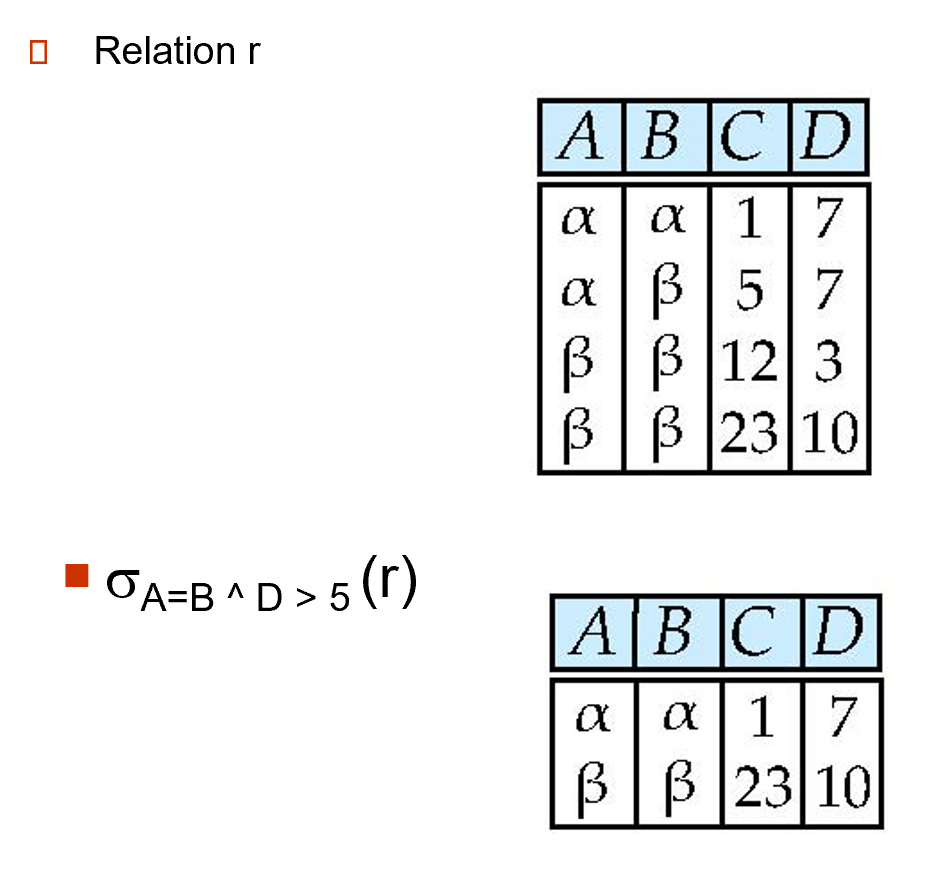
Project¶
The project operation is a unary operation that returns its argument relation, with certain attributes left out.
\(\prod_{A_1,A_2,\ldots, A_k}(r)\) where \(A_i\) are attribute names and \(r\) is a relation name.
The result is defined as the relation of k columns obtained by erasing the columns that are not listed. 会对结果进行去重。
Projection Example
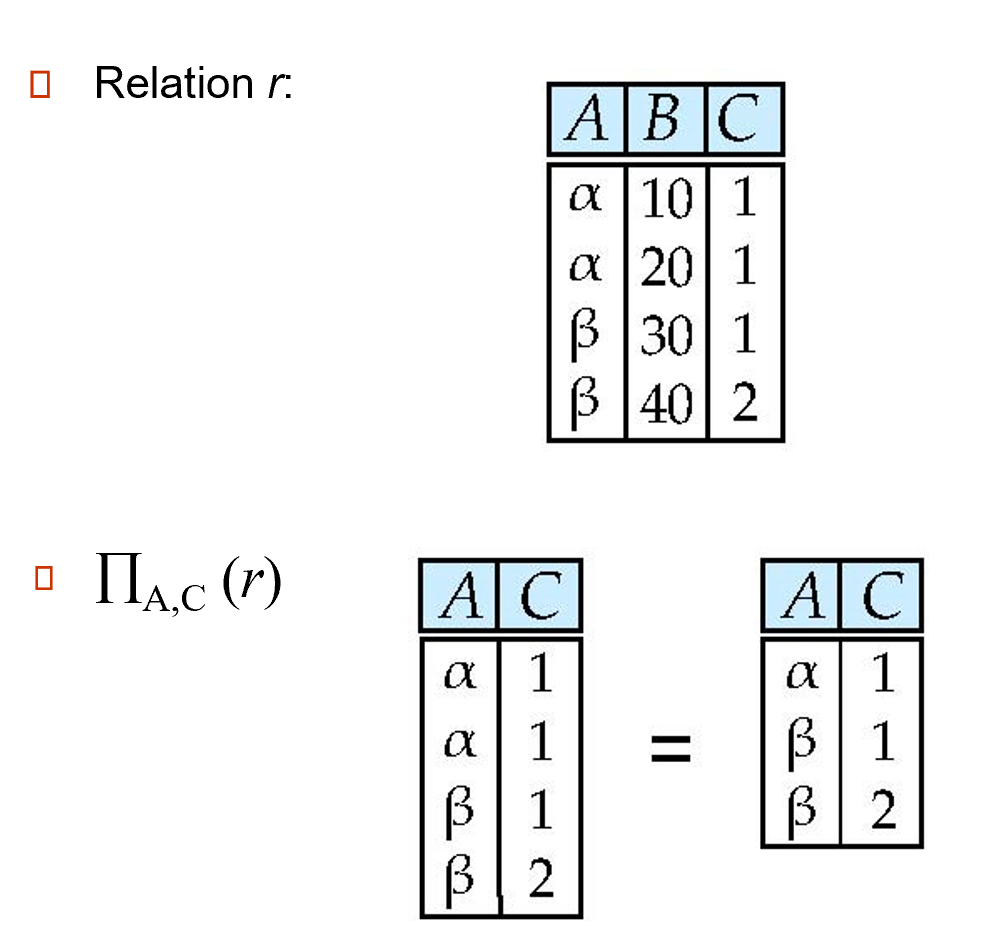
Union¶
The union operation allows us to combine two relations.
\(r\cup s = \{t| t\in r \ or \ t\in s\}\)
- \(r\) and \(s\) must have the same arity ( 元数 ) (same number f attributes)
- The attribute domains must be compatible
当属性有关联类型时,对于每个输入 \(i\), 两个输入关系的第 \(i\) 个属性的类型必须相同。
Projection Example
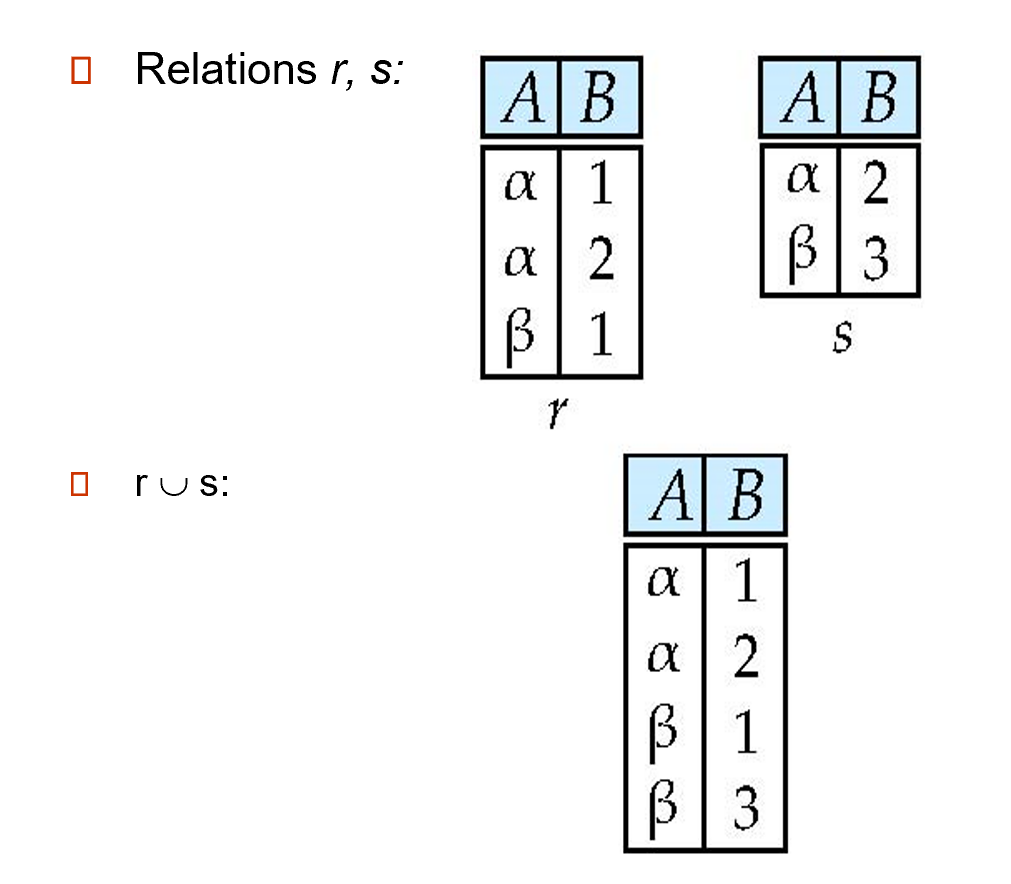
Set Difference¶
The set-difference operation allows us to find tuples that are in one relation but are not in another.
\(r-s=\{t|t\in r\ and\ t\notin s\}\)
Set differences must be taken between compatible relations.
Projection Example
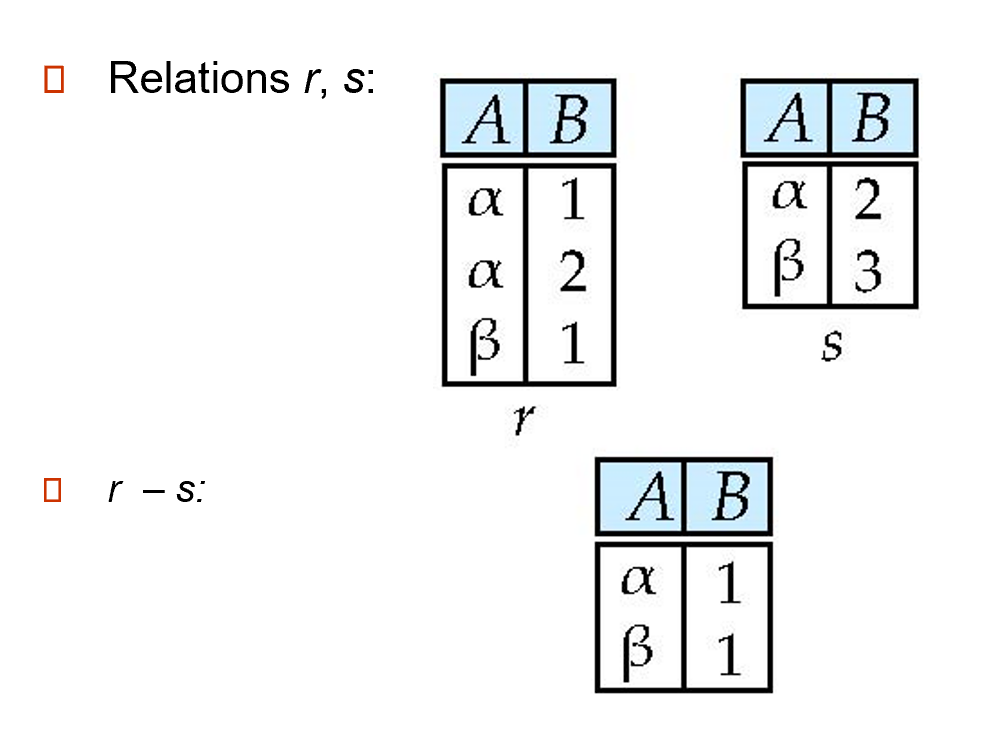
Cartesian-Product¶
The Cartesian-product operation (denoted by \(\times\)) allows us to combine information from any two relations.
\(r\times s =\{t\ q|t\in r\ and\ q\in s\}\)
Projection Example

Rename=n¶
Allows us to refer to a relation by more than one name.
\(\rho_X(E)\)
Composition of Operations 1
Find the names of all instructors in the Physics department, along with the course_id of all courses they have taught.

这两条语句含义一样,但第二条我们先进行了一次 select, 条目少了更高效。
Composition of Operations 2
Find the largest salary in the university.
- find instructor salaries that are less than some other instructor salary (i.e. not maximum)
using a copy of instructor under a new name \(d\).
\(\prod_{instructor.salary}(\sigma_{instructor.salary<d.salary}(instructor \times \rho_d(instructor)))\) - find the largest salary
\(\prod_{instructor}-\prod_{instructor.salary}(\sigma_{instructor.salary}<d.salary(instructor\times \rho_d(instructor)))\)
我们第一步将两个关系拼起来之后,限定 instructor 的工资小于 d, 随后投影我们就可以获得所有不是最大值的薪水
Additional Operations¶
- Set intersection: \(r \cap s\)
- Natural join: \(r\bowtie s\)
- Assignment: \(\leftarrow\)
- Outer join : \(r \rtimes s\), \(r \ltimes s\), \(r\)⟗\(s\)
- Division Operator: \(r \div s\)
Set-Intersection¶
The set-intersection operation allows us to find tuples that are in both the input relations.
\(r\cap s=\{t| t\in r\ and\ t\in s\}\)
- \(r, s\) have the same arity
- attributes of \(r\) and s are compatible
Set-Intersection Operation Example
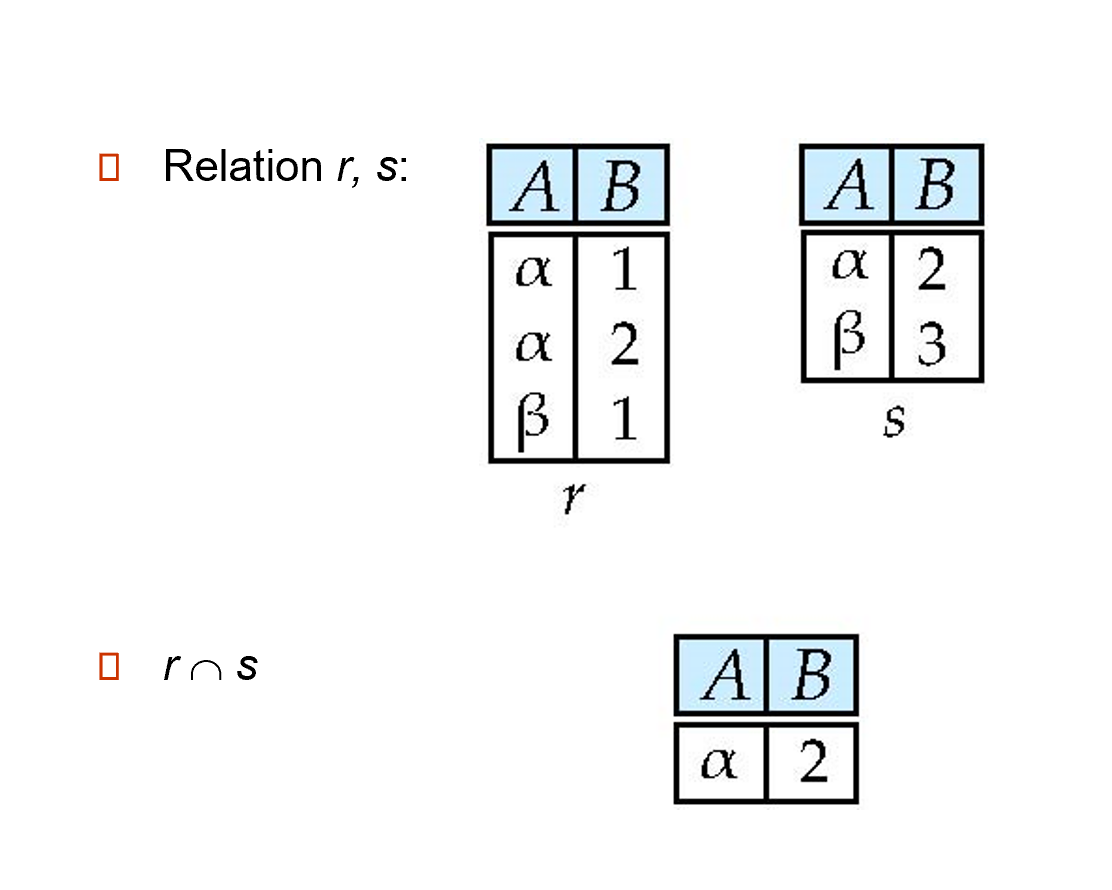
Natural-Join Operation¶
Let r and s be relations on schemas R and S respectively. Then, \(r\bowtie s\) is a relation on schema \(R \cup S\) obtained as follows:
- Consider each pair of tuples \(t_r\) from \(r\) and \(t_s\) from \(s\).
- If \(t_r\) and \(t_s\) have the same value on each of the attributes in \(R \cap S\), add a tuple $t $ to the result, where
- \(t\) has the same value as \(t_r\) on \(r\)
- \(t\) has the same value as \(t_s\) on \(s\)
即共同属性要有相同的值,才能在拼接后的结果中保留。
对乘法的扩展,相当于先 \(\times\) 再 select, 最后 project.
Natural Join Example
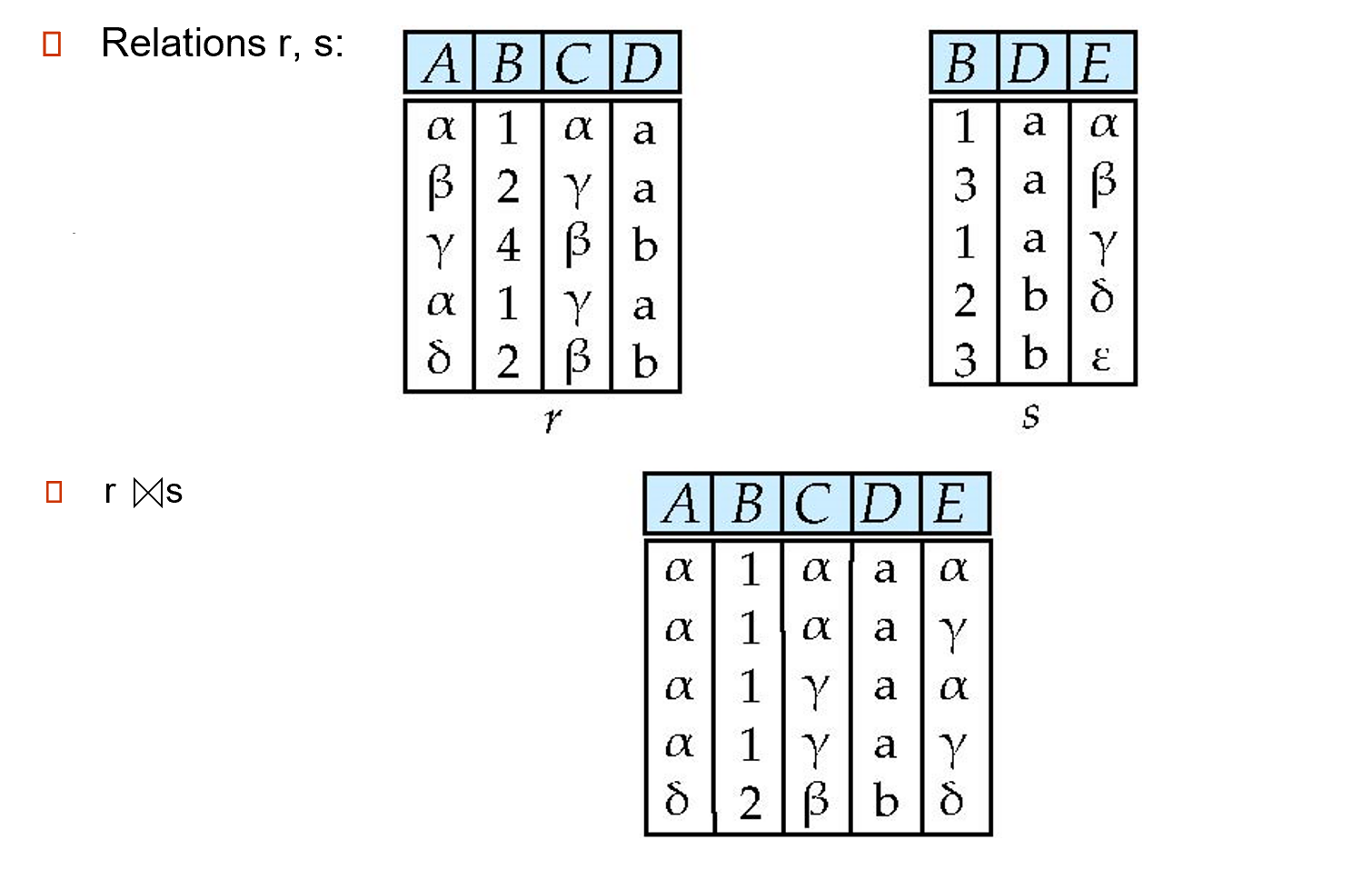
- Theta Join
\(r\bowtie_\theta s=\sigma_\theta (r\times s)\)
条件连接
Outer Join¶
Computes the join and then adds tuples form one relation that does not match tuples in the other relation to the result of the join.
Uses null values:
- null signifies that the value is unknown or does not exist
- All comparisons involving null are (roughly speaking) false by definition
Outer join can be expressed using basic operations.
- \(r\rtimes s=(r\bowtie s)\cup (r-\cap_R(r\bowtie s)\times \{null,\ldots,null\})\)
- \(r\ltimes s=(r\bowtie s)\cup \{null,\ldots,null\}\times (s-\cap_R(r\bowtie s))\)
- \(r\)⟗\(s\) \(=(r\bowtie s)\cup (r-\cap_R(r\bowtie s))\times \{(null, \ldots)\}\cup\{(null,\ldots,null)\}\times (s-\cap_s(r\bowtie s))\)
Outer Join Example


Semijoin¶
\(r\ltimes_\theta s\) 保留 \(r\) 中能与 \(s\) 相连的元组。
Semijoin Example

Division¶
Given relations \(r(R)\) and \(s(S)\), such that \(S \subset R\), \(r\div s\) is the largest relation \(t(R-S)\) such that \(t\times s \subsetneqq r\)
We can write \(r\div s\) as
Division Example

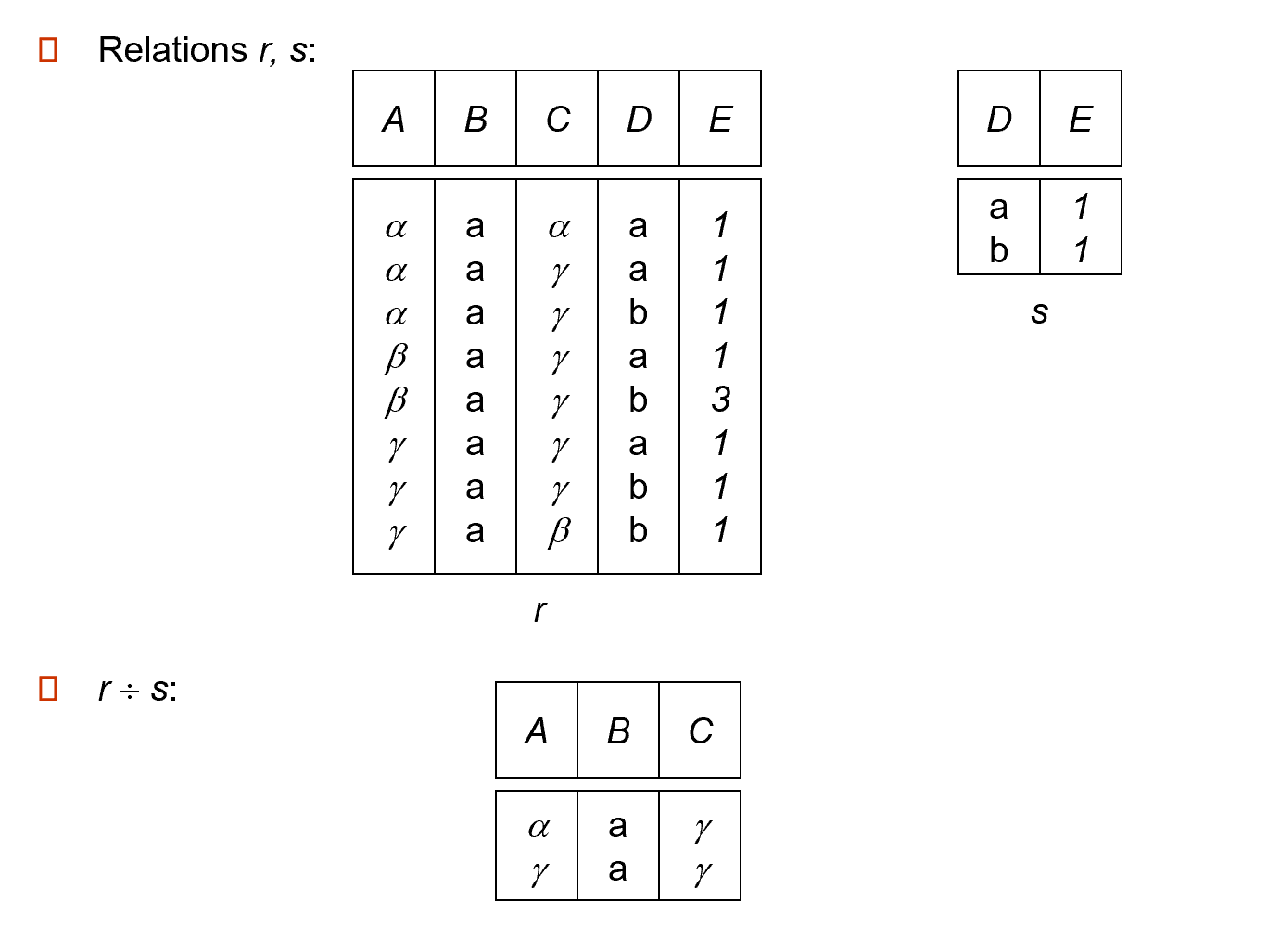
Aggregate Functions and Operations¶
-
Aggregation function(聚合函数)takes a collection of values and returns a single value as a result.
- avg: average value
- min: minimum value
- max: maximum value
- sum: sum of values
- count: number of values
-
Aggregate operation in relational algebra \(G_1,G_2,\ldots,G_n \mathcal{G}_{F_1(A_1),\ldots F_n(A_n)}(E)\)
Aggregate Operation Example

分组结果没有名字,可以用 rename 或者 as 进行改名。
e.g. dept_name G avg(salary) as avg_sal (instructor)
Multiset Relational Algebra¶
关系代数中,我们要求关系要是一个严格的集合。
但实际数据库中并不是,而是一个多重集,允许有重复元素存在。
因为一些操作的中间结果会带来重复元素,要保持集合特性开销很大,因此实际操作中不会去重 。
SQL and Relational Algebra¶
select A1, A2, ... An from r1, r2, ... rm where Pis equivalent to \(\Pi_{A_1,\ldots, A_n}(\sigma_P(r_1\times r_2\ldots r_m))\)select A1, A2, sum(A3) from r1, r2, ... rm where P group by A1, A2is equivalent to \(A_1, A_2 \mathcal{G} sum(A_3)(\sigma_P(r_1\times r_2\times\ldots r_m))\)
这里按 \(A_1,A_2\) 分组,那么结果的表中会有 \(A_1,A_2,sum(A_3)\) 三列(分组依据+分组后的聚合结果),这里我们需要的就是这三列,所以分组即可。但是假设我们只需要 \(A_1, sumA3\) 那么最后还需要投影。